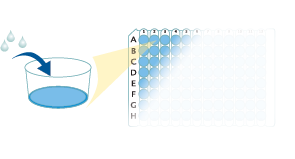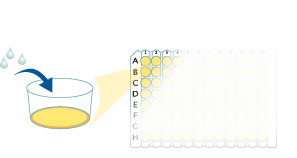Human CX3CL1/Fractalkine Quantikine ELISA Kit Summary
Product Summary
Precision
Cell Culture Supernates, Saliva
| Intra-Assay Precision | Inter-Assay Precision | |||||
|---|---|---|---|---|---|---|
| Sample | 1 | 2 | 3 | 1 | 2 | 3 |
| n | 20 | 20 | 20 | 40 | 40 | 40 |
| Mean (pg/mL) | 1.18 | 3.33 | 6.43 | 1.19 | 3.53 | 6.85 |
| Standard Deviation | 0.03 | 0.11 | 0.24 | 0.07 | 0.15 | 0.31 |
| CV% | 2.5 | 3.4 | 3.7 | 6.1 | 4.3 | 4.5 |
Serum, EDTA Plasma, Heparin Plasma, Urine, Human Milk
| Intra-Assay Precision | Inter-Assay Precision | |||||
|---|---|---|---|---|---|---|
| Sample | 1 | 2 | 3 | 1 | 2 | 3 |
| n | 20 | 20 | 20 | 40 | 40 | 40 |
| Mean (pg/mL) | 1.24 | 3.8 | 7.12 | 1.23 | 3.59 | 6.88 |
| Standard Deviation | 0.04 | 0.08 | 0.17 | 0.11 | 0.2 | 0.37 |
| CV% | 3.2 | 2.1 | 2.4 | 8.9 | 5.6 | 5.4 |
Recovery
The recovery of Fractalkine spiked to three different levels throughout the range of the assay in various matrices was evaluated.
| Sample Type | Average % Recovery | Range % |
|---|---|---|
| Cell Culture Media (n=4) | 98 | 93-102 |
| EDTA Plasma (n=4) | 101 | 88-113 |
| Heparin Plasma (n=4) | 97 | 85-108 |
| Serum (n=4) | 99 | 88-111 |
| Urine (n=4) | 96 | 86-109 |
Linearity
Scientific Data
Product Datasheets
Preparation and Storage
Background: CX3CL1/Fractalkine
CX3CL1/Fractalkine is a transmembrane adhesion protein with a chemokine domain separated from the membrane by a mucin stalk. It is upregulated on many cell types during inflammation. The chemokine and mucin regions can be shed as a soluble chemokine that signals through the receptor CX3CR1. During extravasation, membrane-bound CX3CL1 traps leukocytes, then is cleaved to allow diapedesis. Soluble CX3CL1 protects neurons from microglial neurotoxicity, recruits macrophages for wound healing, recruits osteoclast precursors for bone resorption, and contributes to pathogenesis in coronary artery disease.
Assay Procedure
Refer to the product- Prepare all reagents, standard dilutions, and samples as directed in the product insert.
- Remove excess microplate strips from the plate frame, return them to the foil pouch containing the desiccant pack, and reseal.
- Add 100 µL of Assay Diluent to each well.
- Add 100 µL of Standard, control, or sample to each well within 15 minutes. Cover with a plate sealer, and incubate at 2-8 °C for 3 hours.
- Aspirate each well and wash, repeating the process 3 times for a total of 4 washes.
- Add 200 µL of cold Conjugate to each well. Cover with a new plate sealer, and incubate at 2-8 °C for 1 hour.
- Aspirate and wash 4 times.
- Add 200 µL Substrate Solution to each well. Incubate at room temperature for 30 minutes. PROTECT FROM LIGHT.
- Add 50 µL of Stop Solution to each well. Read at 450 nm within 30 minutes. Set wavelength correction to 540 nm or 570 nm.





Citations for Human CX3CL1/Fractalkine Quantikine ELISA Kit
R&D Systems personnel manually curate a database that contains references using R&D Systems products. The data collected includes not only links to publications in PubMed, but also provides information about sample types, species, and experimental conditions.
26
Citations: Showing 1 - 10
Filter your results:
Filter by:
-
A Small Molecule Antagonist of CX3CR1 (KAND567) Inhibited the Tumor Growth-Promoting Effect of Monocytes in Chronic Lymphocytic Leukemia (CLL)
Authors: Zhong, W;Kokhaei, P;Mulder, TA;Ghaderi, A;Moshfegh, A;Lundin, J;Palma, M;Schultz, J;Olin, T;Österborg, A;Mellstedt, H;Hojjat-Farsangi, M;
Cancers
Species: Human
Sample Types: Plasma
-
Cytomegalovirus Immunity, Inflammation and Cognitive Abilities in the Elderly
Authors: J Hesson, N Fudge, M Grant
Viruses, 2021-11-21;13(11):.
Species: Human
Sample Types: Plasma
-
Systemic and mucosal immune profiling in asymptomatic and symptomatic SARS-CoV-2-infected individuals reveal unlinked immune signatures
Authors: S Ravichandr, G Grubbs, J Tang, Y Lee, C Huang, H Golding, S Khurana
Science Advances, 2021-10-13;7(42):eabi6533.
Species: Human
Sample Types: Nasal Lavage Fluid
-
Early postoperative urinary MCP-1 as a potential biomarker predicting acute rejection in living donor kidney transplantation: a prospective cohort study
Authors: HR Jang, M Kim, S Hong, K Lee, MY Park, KE Yang, CJ Lee, J Jeon, KW Lee, JE Lee, JB Park, K Kim, GY Kwon, YG Kim, DJ Kim, W Huh
Scientific Reports, 2021-09-22;11(1):18832.
Species: Human
Sample Types: Urine
-
B cell and monocyte phenotyping: A quick asset to investigate the immune status in patients with IgA nephropathy
Authors: S Sendic, L Mansouri, S Lundberg, A Nopp, SH Jacobson, J Lundahl
PLoS ONE, 2021-03-19;16(3):e0248056.
Species: Human
Sample Types: Plasma
-
Peritoneal dialysate-range hypertonic glucose promotes T cell IL-17 production that induces mesothelial inflammation
Authors: A Helmke, AM Hüsing, S Gaedcke, N Brauns, MS Balzer, M Reinhardt, M Hiss, N Shushakova, D de Luca, I Prinz, H Haller, S von Vietin
Eur. J. Immunol., 2020-09-30;0(0):.
Species: Human
Sample Types: Serum
-
Cathepsin S activation contributes to elevated CX3CL1 (fractalkine) levels in tears of a Sj�gren's syndrome murine model
Authors: R Fu, H Guo, S Janga, M Choi, W Klinngam, MC Edman, SF Hamm-Alvar
Sci Rep, 2020-01-29;10(1):1455.
Species: Human
Sample Types: Cell Culture Supernates
-
Neutrophil extracellular traps and monocyte subsets at the culprit lesion site of myocardial infarction patients
Authors: A Mangold, TM Hofbauer, AS Ondracek, T Artner, T Scherz, WS Speidl, KA Krychtiuk, R Sadushi-Ko, J Jakowitsch, IM Lang
Sci Rep, 2019-11-08;9(1):16304.
Species: Human
Sample Types: Plasma
-
Prognostic Value of Human Peripheral Monocyte Subsets for Future Coronary Events in Patients Without Significant Coronary Artery Stenosis
Authors: M Kashiwagi, T Imanishi, Y Ozaki, A Taruya, T Nishiguchi, Y Katayama, T Tanimoto, A Kuroi, T Kubo, A Tanaka, T Akasaka
Circ. J., 2019-09-11;0(0):.
Species: Human
Sample Types: Plasma
-
Sulfisoxazole inhibits the secretion of small extracellular vesicles by targeting the endothelin receptor A
Authors: EJ Im, CH Lee, PG Moon, GG Rangaswamy, B Lee, JM Lee, JC Lee, JG Jee, JS Bae, TK Kwon, KW Kang, MS Jeong, JE Lee, HS Jung, HJ Ro, S Jun, W Kang, SY Seo, YE Cho, BJ Song, MC Baek
Nat Commun, 2019-03-27;10(1):1387.
Species: Human
Sample Types: Cell Culture Supernates
-
Augmented concentrations of CX3CL1 are associated with interstitial lung disease in systemic sclerosis
Authors: AM Hoffmann-V, SS Weigt, V Palchevski, E Volkmann, R Saggar, N Li, Ø Midtvedt, MB Lund, T Garen, MC Fishbein, A Ardehali, DJ Ross, T Ueland, P Aukrust, JP Lynch, RM Elashoff, Ø Molberg, JA Belperio
PLoS ONE, 2018-11-20;13(11):e0206545.
Species: Human
Sample Types: Tissue Homogenates
-
Lipopolysaccharide-Binding Protein Downregulates Fractalkine through Activation of p38 MAPK and NF-?B
Authors: X Huang, Y Zeng, Y Jiang, Y Qin, W Luo, S Xiang, SR Sooranna, L Pinhu
Mediators Inflamm., 2017-05-29;2017(0):9734837.
Species: Rat
Sample Types: Serum
-
Assessment of the Role of Metabolic Determinants on the Relationship between Insulin Sensitivity and Secretion
PLoS ONE, 2016-12-21;11(12):e0168352.
Species: Human
Sample Types: Plasma
-
Altered Monocyte and Endothelial Cell Adhesion Molecule Expression Is Linked to Vascular Inflammation in Human Immunodeficiency Virus Infection
Authors: M Kulkarni, E Bowman, J Gabriel, T Amburgy, E Mayne, DA Zidar, C Maierhofer, AN Turner, JA Bazan, SL Koletar, MM Lederman, SF Sieg, NT Funderburg
Open Forum Infect Dis, 2016-10-15;3(4):ofw224.
Species: Human
Sample Types: Plasma
-
T lymphocytes and fractalkine contribute to myocardial ischemia/reperfusion injury in patients.
Authors: Boag S, Das R, Shmeleva E, Bagnall A, Egred M, Howard N, Bennaceur K, Zaman A, Keavney B, Spyridopoulos I
J Clin Invest, 2015-07-13;125(8):3063-76.
Species: Human
Sample Types: Serum
-
Fractalkine-CX3CR1-dependent recruitment and retention of human CD1c+ myeloid dendritic cells by in vitro-activated proximal tubular epithelial cells.
Authors: Kassianos A, Wang X, Sampangi S, Afrin S, Wilkinson R, Healy H
Kidney Int, 2015-01-14;87(6):1153-63.
Species: Human
Sample Types: Tissue Homogenates
-
Early detection of malignant pleural mesothelioma in asbestos-exposed individuals with a noninvasive proteomics-based surveillance tool.
Authors: Ostroff R, Mehan M, Stewart A, Ayers D, Brody E, Williams S, Levin S, Black B, Harbut M, Carbone M, Goparaju C, Pass H
PLoS ONE, 2012-10-03;7(10):e46091.
Species: Human
Sample Types: Serum
-
Fractalkine is an independent predictor of mortality in patients with advanced heart failure.
Thromb Haemost, 2012-09-26;108(6):1220-7.
Species: Human
Sample Types: Plasma
-
Fractalkine is expressed in early and advanced atherosclerotic lesions and supports monocyte recruitment via CX3CR1.
Authors: Stolla M, Pelisek J, von Bruhl M, Schafer A, Barocke V, Heider P, Lorenz M, Tirniceriu A, Steinhart A, Bauersachs J, Bray P, Massberg S, Schulz C
PLoS ONE, 2012-08-20;7(8):e43572.
Species: Human
Sample Types: Serum
-
Systemic biomarkers of inflammation and haemostasis in patients with chronic necrotizing pulmonary aspergillosis.
BMC Infect Dis, 2012-06-25;12(0):144.
Species: Human
Sample Types: Serum
-
Activated innate immunity and the involvement of CX3CR1-fractalkine in promoting hematuria in patients with IgA nephropathy.
Kidney Int., 2012-05-09;82(5):548-60.
Species: Human
Sample Types: Urine
-
Altered expression of CX3CL1 in patients with epilepsy and in a rat model.
Authors: Xu Y, Zeng K, Han Y, Wang L, Chen D, Xi Z, Wang H, Wang X, Chen G
Am. J. Pathol., 2012-03-27;180(5):1950-62.
Species: Human
Sample Types: CSF
-
Identification of the chemokine CX3CL1 as a new regulator of malignant cell proliferation in epithelial ovarian cancer.
Authors: Gaudin F, Nasreddine S, Donnadieu AC, Emilie D, Combadiere C, Prevot S, Machelon V, Balabanian K
PLoS ONE, 2011-07-07;6(7):e21546.
Species: Human
Sample Types: Cell Culture Supernates
-
Fractalkine is a novel human adipochemokine associated with type 2 diabetes.
Authors: Shah R, Hinkle CC, Ferguson JF, Mehta NN, Li M, Qu L, Lu Y, Putt ME, Ahima RS, Reilly MP
Diabetes, 2011-05-01;60(5):1512-8.
Species: Human
Sample Types: Plasma
-
Characterization of synergistic induction of CX3CL1/fractalkine by TNF-alpha and IFN-gamma in vascular endothelial cells: an essential role for TNF-alpha in post-transcriptional regulation of CX3CL1.
Authors: Matsumiya T, Ota K, Imaizumi T
J. Immunol., 2010-03-15;184(8):4205-14.
Species: Human
Sample Types: Cell Culture Supernates
-
Constitutive endocytosis of the chemokine CX3CL1 prevents its degradation by cell surface metalloproteases.
Authors: Huang YW, Su P, Liu GY, Crow MR, Chaukos D, Yan H, Robinson LA
J. Biol. Chem., 2009-09-01;284(43):29644-53.
Species: Human
Sample Types: Cell Culture Supernates
FAQs
No product specific FAQs exist for this product, however you may
View all ELISA FAQsReviews for Human CX3CL1/Fractalkine Quantikine ELISA Kit
Average Rating: 4.8 (Based on 4 Reviews)
Have you used Human CX3CL1/Fractalkine Quantikine ELISA Kit?
Submit a review and receive an Amazon gift card.
$25/€18/£15/$25CAN/¥75 Yuan/¥2500 Yen for a review with an image
$10/€7/£6/$10 CAD/¥70 Yuan/¥1110 Yen for a review without an image
Filter by:









